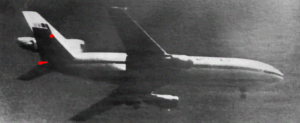No headline provided

October 27, 2009
Twenty years ago, on July 19, 1989, United Airlines Flight 232crash landed in Sioux City, Iowa, U.S.. 111 of those on board werekilled – but the actions of the crew helped save the other 185flying on the DC-10.
The airliner was a trijet, with one engine mounted in the tail.This engine had a cracked fan disc which went undetected by theairline despite inspections, and on that flight the componentfailed completely, shattering and sending debris flying. Thisdebris damaged all three hydraulic systems that controlled theaircraft, leaving the jet without any conventional means ofcontrol. “We had no ailerons. We had no rudder. We had no elevator.We had no spoilers. We had no wing flaps. Everything thatcontrolled the movement of the airplane we lost,” said CaptainAlfred C. Haynes.
The pilots were quickly joined by a DC-10 instructor who wastraveling as a passenger, and together they improvised a method of’skid steering’ the aircraft. Captain Haynes recalls “[We had]these two engines, and by varying the thrust on those two engines,we could skid the airplane one way or the other. And if you thrustboth throttles up at the same time, the increase in thrust wouldpitch the nose up, and if you closed both throttles it would pitchthe nose down.”
The flight crew flew the aircraft in this manner for 45 minutesbefore reaching Sioux Gateway Airport in Iowa’s Soiux City. “Itlooked real good. I thought he was going to make it,” said airtraffic controller Kevin Bachman of the moments before touchdown.But it wasn’t to be: the right wing dropped down and struck therunway, sending the aircraft cartwheeling down the tarmac until itbroke up in a fireball.
Haynes was knocked out in the accident, and when he came to he”asked if everybody made it. And [flight engineer] Dudley said no.And I said Oh my God, I killed people.” The accident occurred astwo nearby hospitals were changing shifts,meaning plenty ofemergency personnel were on hand to help with the rescue effort.The National Guard were also in the area.
Haynes has since come to terms with the accident. He doescontinue to provide lectures on pulling as a team in challengingcircumstances. Today his stance upon the praise directed towardshim and his crew is that “If you’re going to call a hero, you’vegot to call everyone involved. The hundreds or thousands involvedin the whole operation.”
A ceremony was held in Sioux City to mark the anniversary.Former 185th Air National Guard chaplain and doctor Dr. GregoryClapper, who counseled victims and rescuers alike, commented that”Humans are historical beings. When we suffer a loss, the date ofthe loss becomes so significant. Although it may not be objectivelyimportant to others, taking note of that date may be beneficial forthose who suffered the loss,” he said at the event in Chris LarsenPark.
The National Transportation Safety Board’s investigationresulted in new procedures for the way airlines inspect theiraircraft in the U.S. However modest Haynes and his fellow crewmembers may be, the fact remains that twenty years on theirachievements remain recognized as one of the world’s mostremarkable displays of airmanship in the face of the odds.






















Leave a Comment